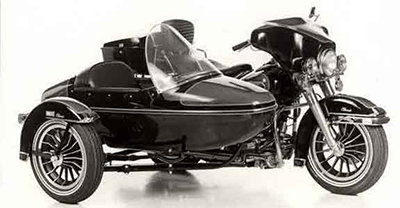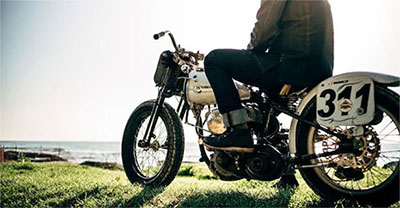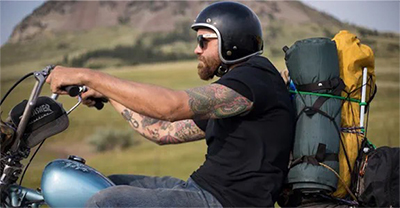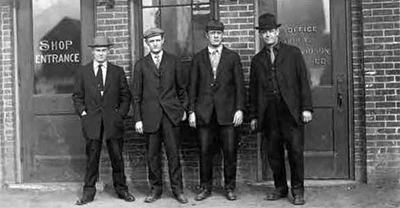Born out of boyhood friendship, it took one Harley and three Davidsons to create a motorcycle brand that reshaped how the world moves. Discover the evolution of Harley-Davidson through the ingenuity of its founders, wartime resilience, iconic models, and enduring legacy that ultimately became a globally recognized brand that changed the face of transportation and American culture.
You might think that Harley-Davidson was founded by two guys whose last names were Harley and Davidson, and you would be partway right.
It was one Harley and three Davidsons, and it took all four of them working together to create a brand that would revolutionize transportation and America.
QUICK FACTS ABOUT HARLEY-DAVIDSON'S HISTORY:
What year was Harley-Davidson founded: 1903
When was the first Harley-Davidson made: 1903
Where did Harley-Davidson start: Milwaukee, Wisconsin
What is Harley-Davidson's country of origin: United States
How old are Harley-Davidson motorcycles: 2025 marks the 122nd anniversary
WHEN WAS HARLEY-DAVIDSON OFFICIALLY FOUNDED?
Harley-Davidson was founded in 1903 in Milwaukee, WI and officially incorporated in 1907, with Walter Davidson serving as the first president. Arthur Davidson became the first general sales manager and secretary, while William Davidson was the first operations manager. William Harley, meanwhile, became the chief engineer and treasurer.
Given the ratio of three Davidsons to one Harley, you may wonder why the company wasn't called Davidson-Harley. Since the original idea for the motorcycle came from William Harley, the gang thought it was only fair to have his name first.
WHO WERE THE FOUNDERS OF HARLEY-DAVIDSON?
A frequent question is whether Harley-Davidson refers to one individual. It’s four people: William Harley plus Walter, William, and Arthur Davidson. Their friendship, mechanical insight, and boldness led to the birth of a company that revolutionized an emerging industry.
Growing up just a few houses apart, William Harley and Arthur Davidson merged their passion for cycling into an idea that blossomed into a motorized project.
EARLY INFLUENCES
Both boys were enamored with bicycles. William even took a job at a Milwaukee-based bicycle factory when he was 15, rising from the rank of cycle fitter to drafter, which led him to work as a draftsman at the Barth Manufacturing Company. It was there that he designed his first internal combustion engine. It was based on the French de Dion-Bouton engine, which would go on to be used by many early motorcycle manufacturers.
Along with Arthur, another draftsman from Barth, and a friend whose father owned a lathe, William and his cohorts would spend the next several years working on a proto motorcycle in their spare time. The prototype fizzled out, but it proved valuable because it made William and Arthur realize that they needed a machinist.
The two reached out to Arthur's older brother Walter, who was living in Parsons, Kansas, at the time. Walter arrived expecting to see a motorcycle but instead was greeted by an unfinished mess. But in that mess Walter saw a dream, so he decided to stay in Milwaukee to make William and Arthur's dream a reality.
Soon, another mechanic, William Davidson, Arthur's eldest brother joined the trio. By 1904, a second prototype was completed. It was the first-ever Harley-Davidson® motorcycle to participate in a motorcycle race. And while it didn't win, the team was already off and running to make motorcycle history!
WILLIAM HARLEY
William was the first chief engineer and treasurer of Harley-Davidson. The idea for the motorcycle was his, although he certainly couldn't have done it without the Davidson brothers.
Early Life
Engineering ran in the Harley family. William Harley Sr. was a railway engineer who emigrated to the United States in 1860 from England along with his wife, Mary Smith. William Jr. was born 20 years later in 1880.
When not working on prototypes of the original motorcycle, Harley was pursuing a degree in mechanical engineering from the University of Wisconsin-Madison, which he earned in 1907.
Career
Harley first began tinkering with the idea of a motorcycle while working at Barth Manufacturing Company. Throughout the years, he would build on the successes of his previous models. When the first models were completed in 1903 with a buckle crank, Harley was already trying to figure out how to create a two-cylinder engine, which he did by 1909.
Harley would remain the company's chief engineer and treasurer until his death. He was an indispensable facet of the company's success and crucial in developing and introducing new bikes. An avid racer, he also had the pleasure of testing his latest creations.
Personal Life
In 1910, Harley married Anna Jachthuber, with whom he had three children: Ann Mary, William J., and John.
He died of heart failure on September 18, 1943; he was 62.
Legacy
Harley was inducted into the Motorcycle Hall of Fame in 1998. In 2003, a Harley-Davidson statue was unveiled in Littleport, Cambridgeshire, where Harley's father had been born.
ARTHUR DAVIDSON
Arthur was the youngest Davidson brother, born in Milwaukee, Wisconsin, on February 11, 1881.
Early Life
Arthur developed a friendship with Walter Harley as a child. The two would fish together and shared an interest in biking.
Career
Arthur Davidson was the first general sales manager and secretary of Harley-Davidson. Davidson successfully got the USPS, police departments, and the military to use Harley-Davidson® bikes. He also started a Harley-Davidson® service school responsible for training qualified mechanics.
Davidson saw the value in a coalition of industry insiders and riders working toward the common end of advancing motorcycling. Davidson was inspired to align himself closely with and support the American Motorcyclist Association.
Personal Life
At 69, Davidson was killed in a car crash just three miles south of his home. The accident claimed the lives of Davidson's wife, Clara, and their friends Dorothy and Donald Jeffery. The Davidsons were survived by their three children, Margaret, Arthur Jr., and James Davidson.
Legacy
Arthur was not only instrumental in building the first Harley-Davidson® bikes and founding the company, he was mostly responsible for enshrining the brand's place in American history and popular culture.
WILLIAM DAVIDSON
William "Bill" Davidson was born in Milwaukee, along with his brothers Arthur and Walter.
Early Life
Bill quit his job with the Milwaukee Road railroad to join the crew that would soon become Harley-Davidson. It was quite a risk considering how well paid he was for his job!
Career
Once the original foursome incorporated Harley-Davidson, Bill became the works manager. His responsibilities were to buy the presses and other tools necessary for the manufacturing process.
Throughout his tenure, Bill would keep in close contact with factory employees. They were his eyes on the ground, keeping him abreast of everything necessary to keep the factory running smoothly.
Personal Life
Bill died at the age of 66 on April 21, 1937. His son William G. Davidson would go on to serve as President of Harley-Davidson, as would Bill's grandson John.
Legacy
In addition to his position within the company, Bill was known for his charity and generosity. During the Christmas season, he would make care packages for strangers. He was also known for his amiable disposition, which extended to everyone from machinists to politicians.
WALTER DAVIDSON
Early Life
As a child, Walter raced and repaired bikes. As a teen, he taught himself how to be an electrician and was even known to make his own batteries.
Career
After being called to Milwaukee from Kansas to work on the first motorcycle, Walter became an indispensable part of what would eventually become Harley-Davidson. He joined his brother Arthur and William Harley in finishing the first batch of bikes sold to the public. Walter, it turned out, was responsible for building the first bike.
When Harley-Davidson was incorporated in 1907, Walter became the first President and General Manager. He spent the rest of his life working for Harley-Davidson including delivering speeches to stockholders.
Walter also became a motorcycle enthusiast and won several races as a rider, including the 1908 Federation of American Motorcyclists endurance run in the Catskill Mountains. It was an accomplishment that provided great press for the motorcycle company!
Personal Life
Walter married his wife Emma in 1910. Together they raised three sons: Gordon, Walter Jr., and Robert. Walter died on February 7, 1942, while still President of Harley-Davidson.
Legacy
To this day, no one has been President or CEO of Harley-Davidson for as long as Walter.
WHERE WAS THE FIRST HARLEY FACTORY?
The first Harley-Davidson factory was a wooden shed in the Davidson's backyard. The current headquarters stands in the same location - in a more prominent building.
WHO DEVELOPED THE TWO-CYLINDER ENGINE INNOVATION?
The first three motorcycles produced by Harley-Davidson in 1903 all had a buckle crank, a single-cylinder engine, pedals, and a leather drive belt. You would pedal until enough engine compression was built up, at which point the engine took over.
William Harley, however, envisioned a twin-cylinder setup early on. By 1909, he had perfected the V-Twin motor that could reach speeds as high as 60 mph, a major step forward for speed and power. The company’s output skyrocketed as riders sought reliable machines that could handle new roads and highways.
With such a feat, Harley-Davidson's production rose to 3,200 machines by 1910.
WHAT ARE SOME OF THE MOST POPULAR HARLEY-DAVIDSON MODELS?
While there are too many Harley-Davidson models to list them all, popular models over the years include:
1903 Model 3-Wheel
1905 Model 5-Wheel
1909 Model 10-Wheel
1912 Model X8
1916 Model J
1920 Model F
1923 Model V
1929 Model D
1936 Model EL
1941 Model FL
1948 Model Panhead
1957 Model Sportster®
1965 Model Electra Glide®
1971 Model Super Glide®
1980 Model Softail®
1984 Model Tour Glide
1986 Model Heritage Softail
1990 Fat Boy®
1991 Model Dyna Glide®
1997 Model Road King®
2003 Model V-Rod®
2006 Street Glide®
2014 Electra Glide Ultra Limited®
2015 Road Glide®
2016 Low Rider® S
2020 Pan America®
2022 Low Rider® ST
These are just some of the models produced by Harley-Davidson, and they are continuously evolving and introducing new models.
HOW WAS THE HARLEY-DAVIDSON CULTURE CULTIVATED?
To stir up the press, Harley-Davidson sponsored "The Wrecking Crew," a racing team known for their exhilarating performances. Today it is commonplace for a motorcycle company to sponsor a team, but when Harley-Davidson did it, the move was revolutionary.
The plan was a success, generating plenty of news and sales. Wisely, the company re-invested most of its profits into improving their products.
BRAND IDENTITY AND LEGACY
Arthur Davidson saw opportunity wherever he looked. By 1914 he had the USPS using 4,800 bikes to deliver mail. Soon, the military was using Harley® motorcycles as well. By the 1950s, police departments nationwide were also using a Harley-Davidson® motorcycle.
Many motorcycle cops would use boots, breaches, and saddlebags, which achieved a "Wild West" look which captured the imagination of young boys and the general public.
Seeing a further opportunity, Walter Davidson started marketing the Harley-Davidson® brand using clothing and accessories.
Since then, the company has expanded into motorcycle insurance, a riding academy (for both new and skilled riders), credit cards, and more.
FAMILY CONTINUITY AND GENERATIONAL CONTRIBUTIONS
Later generations carried the torch, remaining closely tied to design, racing, and leadership. Relatives of the founders oversaw product lines, tested experimental models, and continued philanthropic efforts.
This continuity meant the company’s philosophies remained rooted in the original vision of craftsmanship, innovation, and riding enjoyment.
WHY ARE HARLEY-DAVIDSON MOTORCYCLES CALLED HOGS?
The “HOG” nickname has various legends, however, there is no official link to where the “HOG” moniker originates from. However, more than 100 years ago, a member of the Harley-Davidson racing team named Ray Weishaar, shared a Coke with a piglet.
It would become one of the most recognized photos of Harley-Davidson history, and a key moment in the brand's lore.
Almost nothing is said about the piglet after the race, but the two would later be reflected as the source of the “Hog” moniker.
TIMELINE OF KEY EVENTS
Below is a chronological overview of pivotal moments in the company’s history that helped shape its identity:
1901
William Harley begins sketching a small engine blueprint. Initial ideas revolve around motorizing bicycles.
1903
Harley-Davidson launches in a Milwaukee backyard. Assembly takes place in a modest wooden shed, where the founders fine-tune their earliest prototypes.
1907
Official incorporation occurs. Walter Davidson becomes President, Arthur Davidson takes on sales and secretary duties, William Davidson oversees factory operations, and William Harley leads engineering.
1914–1918 (World War I)
Military contracts spur production. Thousands of units ship overseas, boosting brand awareness. Wartime demand drives significant mechanical improvements.
1920
The firm became the globe’s largest motorcycle manufacturer. Upgraded models and successful racing campaigns contribute to widespread recognition.
1929–1933 (Great Depression)
Despite economic collapse, the business endures by cutting costs, refining designs, and emphasizing durability. Strong relationships with dealerships and loyal customers lessen the blow.
1939–1945 (World War II)
Harley-Davidson provides specialized models to the Allied forces. Wartime research fosters advanced innovations that later transfer to civilian lines.
Postwar 1940s–1950s
Victory parades and newfound prosperity propel brand popularity. Returning veterans favor powerful motorcycles, fueling expansions in both domestic and international markets.
1960s–1970s
Iconic styling evolves. The enterprise experiments with fresh designs, introduces modern components, and cultivates a dedicated community of riders.
1980s–1990s
Marketing becomes central. Heritage aesthetics blend with updated technology. Global outreach strengthens ties to custom culture and organized events.
2000s and Beyond
Major anniversaries showcase the company’s storied lineage. Technological advances, global manufacturing partnerships, and sustained racing involvement add fresh chapters to its saga.
WRAPPING UP
Born out of a close-knit friendship, an inventive vision, and an unshakable work ethic, Harley-Davidson developed into a name instantly recognized worldwide. Overcoming difficulties such as economic downturns and stiff competition, the brand consistently redefined what it meant to ride with freedom and style.
It stands as a powerful reminder of what can happen when individuals combine their talents for a shared purpose.

Sidecars are more than just a cocktail. Discover the role sidecars played in commerce, warfare, and the spread of motorcycling's popularity.

Discover the basics of insuring a vintage motorcycle and understanding what special coverage (if any) your vintage bike might need. Learn more!

“America the Beautiful”–there’s no better way to see that beauty than by riding the USA’s roads during a motorcycle event or rally. Get the full list here.

Motorcycles have come a long way since their early days as steamboat powered bicycles and are now considered an indispensable part of many cultures. Discover just how far they’ve come!



